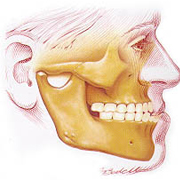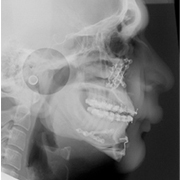Orthognathic surgery is surgery performed on the bones of the jaws to change their positions. Orthognathic surgery is corrective facial surgery where deformities of the jaw exist. It may be indicated for functional, cosmetic, or health reasons. It is surgery commonly done on the jaws in conjunction with orthodontic treatment, which straightens the teeth.
Pre-operative planning is crucial to the success of the procedure and evaluates the surgical and orthodontic options. The surgeon chooses the type of mandibular surgery based on his experience, evaluation of the photographic and cephalometric analysis, and model surgery.
Orthognathic surgery is often delayed until after all of the permanent teeth have erupted unless medical conditions necessitate that the surgery be performed earlier. In adult patients, orthognathic surgery can be combined with soft tissue contouring to improve the aesthetic results.



1. Preoperative diagnosis and planning
The pedodontist, orthodontist plans and diagnosis in coordination with the oral surgeon All findings are analyzed and pre-surgical model surgery performed to ascertain the feasibility of various treatment options
2. Pre-surgical orthodontics
Pre-surgical orthodontics may be necessary to straighten the teeth and align the arches so that a stable occlusion can be obtained post-operatively
3. The maxillary surgery is done
4. Post-surgical orthodontics
Orthodontics following surgery are frequently required to revise minor occlusal discrepancies
The length of recovery in the hospital may vary from one to three days following surgery. During the week following surgery, activities should be limited. All strenuous activities and heavy exercise should be avoided the first month after surgery. Swelling is common, and a brief period of facial discoloration is possible.
